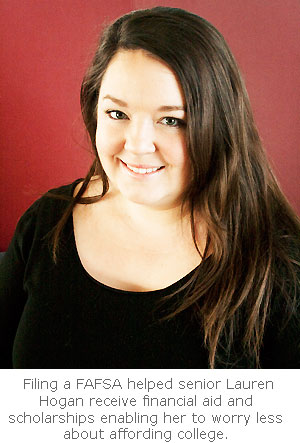

Whether you are a
prospective studentor a
current student, filing the
Free Application for Federal Student Aid (FAFSA)should be first on your “to-do” list this week.
In today’s economic climate, if you are trying to finance a college education chances are you need help.
Financial aid- in the form of grants, federal and state loans or scholarships - has become a necessity. One thing is certain: If you don’t submit the FAFSA by March 2, you’ll never know if you are eligible.
Last year, 84 percent of UC Merced students applied for financial aid. Of those who applied, 91 percent received some form of financial assistance and 87 percent qualified for need-based aid.
“Our goal is to provide all students with as much financial aid as possible to help them pursue their educational goals,” said Diana Ralls, director of the
Office of Financial Aid and Scholarships. “Financial aid is intended to remove financial barriers for families who cannot afford the cost of a higher education and to fill in the gap for families who can afford only part of the cost.”
Ralls estimates the
cost of attendancefor 2010-11 to be about $29,000, including tuition/fees, books and supplies, room and board, personal expenses, transportation expenses and a health insurance allowance.
“Financial aid is a huge factor in their decision to come to UC Merced,” she said.
Family incomes and college savings have been reduced as a result of the sluggish economy making financial aid programs especially important. Submitting a FAFSA is a vital step in receiving aid.
Lauren Hogan, a senior
psychologymajor from Los Angeles, didn’t have to worry about how she was going to pay for tuition and other college related expenses her first two years at UC Merced. Her mother owned her own business and was able to support her financially.
Then, before the start of her junior year, Hogan’s mother lost her restaurant and her means to pay for her daughter’s education.
Like many students, Hogan didn’t apply for financial aid because she figured she wouldn’t qualify. Instead, she started working more hours and resorted to taking out private loans with high interest rates in order to make ends meet.
Hogan said the Office of Financial Aid opened her eyes to the aid available. She applied for a special circumstance and was awarded a Bobcat Scholarship, Pell Grant and Federal Work Study, enabling her to work fewer hours and not worry about affording college.
“If I had known then what I know now, it would have changed everything,” she said. “It is a relief that I don’t have to resort to taking out additional high-interest private loans and also that I don’t have to pay most of it back.”
When Hogan first heard about the fee increase effective spring 2010, she was worried because she hadn’t set aside money to cover the increase. Fortunately, like all aid recipients, she learned that her gift aid package had been increased to offset the increase.
In addition to federal and state aid, grants and scholarships, UC eligible students may qualify for the
Blue and Gold Opportunity Planwhich ensures that students who are eligible have at least enough grant/scholarship aid to cover their systemwide fees. This year, the program has been expanded to include students who have family incomes less than $70,000. To be considered for this plan and other aid, prospective and current students must file their FAFSA form no later than March 2.
“Unfortunately, students don’t always know what (aid)) is available,” Hogan said. “It doesn’t hurt to apply. It is free! The financial aid officers are here to help and will do their best to accommodate every student.”
The only question remaining is “Have you filed your FAFSA?” Well, what are you waiting for?
Log onnow and make sure you get the aid you need to succeed.






